Who wouldn’t love the idea of having their own energy and not be dependable on a national system? Just think about not having to pay the electricity bill every month and you will definitely get the idea. The world of advanced technology designed a device that makes all this possible: the solar panel! Energetic independence and keeping the environment free of pollution are not just a distant dream in today’s reality. We can produce our own electricity in a simple and efficient manner using last generation solar panels.
[the_ad_placement id=”in-text-1-type-r”]Being able to understand the operating principles on these devices may be someday one of the most valuable skills you posses. Let’s imagine a global natural disaster that ravages the world and changes everything. There is no industry, no fuel, the world economy is in total chaos and there are only few survivors left.
After the initial impact, you will want to rebuild the world, but without energy things can be exponentially more difficult. If you know how to build a solar panel and how to store and use the resulted energy, you will be able to have electricity and use technology to your advantage.
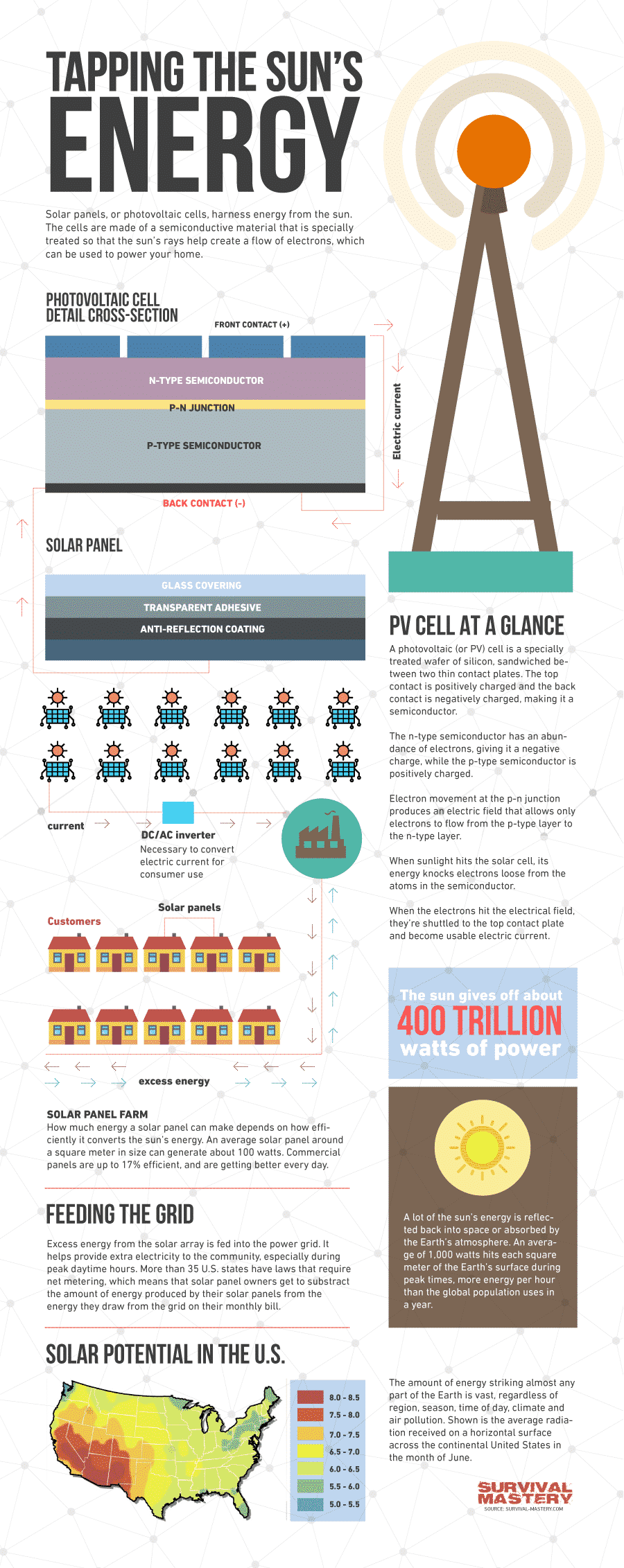
Today we’re going to bring to your attention the mechanisms that are at work inside such a device. We’re going to slice the solar panel up and find out what makes it tick. But first, let’s see what the actual definition of this amazing device is.
Solar panels: definition and basics
The scientific name of these devices is photovoltaics and it basically means light to electricity. Actually this is the simplest definition anyone can offer: solar panels are devices that convert light into electricity. They are usually called solar because our primary and most powerful source of light is the Sun but it’s not the only source of light these panels can react to.
The basic principle is simple: light energy from the Sun (or photons) is used by these solar modules to create energy through the photovoltaic effect which is a phenomenon that implies both physics and chemical reactions.
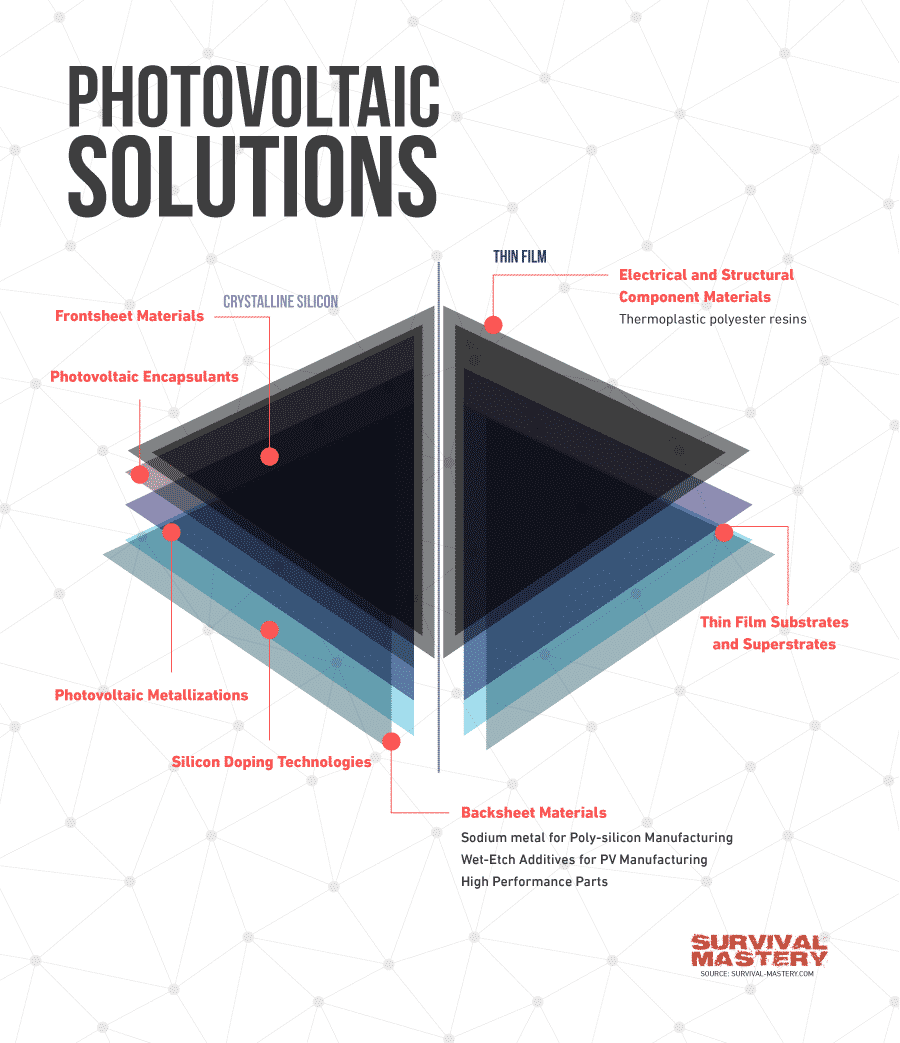
To demonstrate how efficient and advanced the today’s solar technology is, you should know that NASA uses photovoltaics on their spacecrafts to make sure they will always have the necessary power to deploy the missions they are sent in space for. The only problem with these devices is that, they always have to be pointed towards the Sun to receive the maximum light possible.
This is one of the absolute requirements a solar panel has: exposure to light. If the device doesn’t receive direct light, its efficiency is lower which is why, when it comes to household systems, the positioning is extremely important. Also, when it comes to households, solar devices are categorized in three main categories:
- solar hot water panels – these systems use solar energy to heat water required in the household;
- solar thermal collectors – this is a device used for capturing solar radiation from infrared or ultraviolet wavelengths that is converted into electricity;
- photovoltaics – these are the panels that are electrically connected and mounted on a structure for support.
Now that we know what a photovoltaic device is, it’s time to see how it actually works.
The science behind solar devices
The science is quite simple: when the particles of light or photons hit a solar cell, they separate electrons from their atoms thus creating a flow of electricity. And now, we’ve introduced a new element in discussions: the solar cell or the photovoltaic cell. These are small units that put together in a special arrangement, they make a solar panel. So, in conclusion, a solar panel is a gathering or organized solar cells.
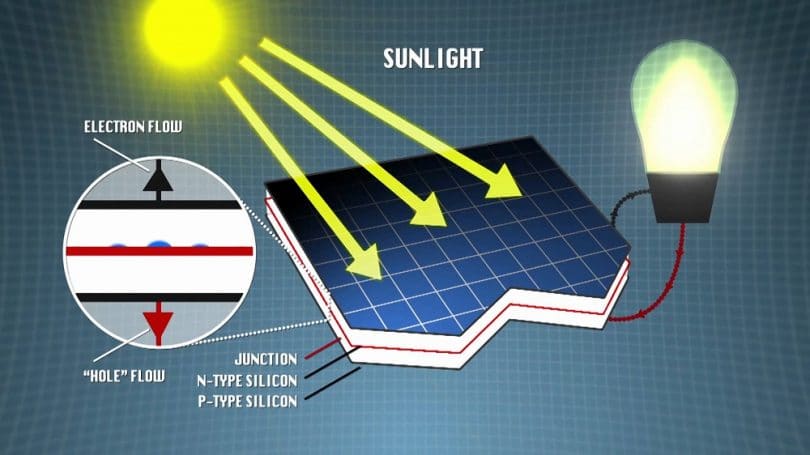
Given the fact that we just found out that all solar devices are based on small units, we consider it’s only fair to start with the small particles first and then advance to the science of the entire device. Which is why, we’re going to discuss the solar cell next.
How do solar cells work: basics and structure
Put shortly, a solar cell is made out of two pieces of a semi-conducting material placed one over the other, just like in a sandwich. The most used semi-conducting material in this care is the silicon due to its property to have both metal and electrical insulator properties. Silicon is combined with other materials to create the necessary charges so the electric current can be created. This is basically why a solar cell is a sandwich, because it needs to create an electric field.
For this to happen, each piece of the cell must have separate opposite charges, which is why the silicon is mixed with other materials. The producers use phosphorus for the top layers to add extra electrons and create a negative charge (n-type), and boron for the bottom layer to reduce the number of electrons and create a positive charge (p-type). When put into a sandwich, the two pieces of silicon, differently charged, create a junction through which the electrons can move.
All this, creates an electric field between the silicon layers and when a photon hits one of these cells, a small portion of its energy is caught in the cell, knocking electrons free while the electric field pushes it through the junction, towards metal conductive plates placed on the side of the solar cells. All these electrons are collected and sent through wires to power your appliances.
The best analogy to this entire explanation is a game of pool: the white ball is a photon and all the other balls are atoms waiting to be hit. When the white ball hits another ball, electrons are put into move and they are transferred through wires (the tubes beneath the table) until they reach their target.
As you can see the theoretic process is simple and it is governed by simple laws but in reality things are a bit more complicated.
Silicon’s special properties used for solar cells
You might wonder what makes silicon such a special material that most producers like to use it. Well, we’re here to explain things thoroughly so read on if you want to know more about solar cells and the materials they’re made of.
In crystalline form, silicon has some special properties that are due to its special structure of 14 electrons. These electrons are arranged in three shells, two of which are complete. It’s because his external shell is incomplete, an atom of silicon will always try to bond with the 4 nearest atoms. This is the property that actually forms the crystalline form which is so important for photovoltaic devices.
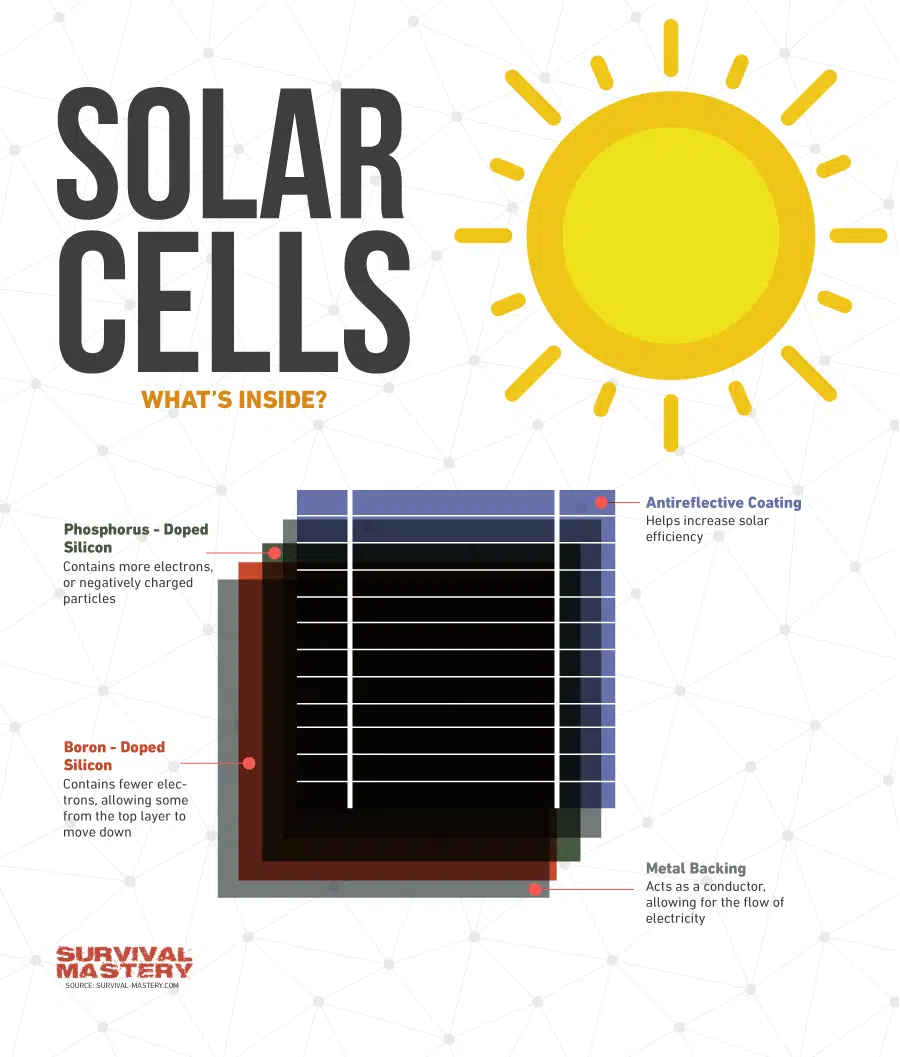
Because silicon in its pure crystalline form is not a good electric conductor, producers add other materials to the mix (as explained above). We already specified that phosphorus is one of the other elements added and here is why: phosphorus has 5 electrons in the outer shell and as it still bonds with 4 of his neighboring silicon atoms, it still has one left. This means adding a negative charge to the silicon used for solar cells: having extra electrons to play with.
When energy (as light or heat) is added to the material, some electrons will break free because there is no strong bond to keep them in place. When they leave their places, a hole remains in the structure and they go wondering around, looking for a new hole. This is what actually forms an electrical current.
Another element added in the mix is boron and this one has only 3 electrons thus leaving holes in the structure. This helps charge the silicon positively. The process of spiking pure crystalline silicone with other elements is called doping and it is used to create much better conductors.
Studying a solar cell’s anatomy
We already specified that the two pieces of silicon must be brought together, and arranged in a sandwich structure, so an electric field can be formed. Let’s see what this means and why we need this.
When the two pieces of silicon (n-type and p-type) come in contact, all the free electrons in the n-type side will want to go in the free holes in the p-type part. You might think that there’s no way an electric field could be formed if the electrons from one side are transferred in the hole in the other side, and you would be right. Still, at the junction between the two pieces of silicon, a barrier is formed and it gets difficult for electrons to travel to the other side.
[the_ad_placement id=”in-text-2-type-r”]When a balance is reached, there is an electrical field between the two silicon pieces of the solar cell. This field also has a direction: from the P side to the N side and never reverse. This allows free electrons in the P side to move over in the N side which means that we’ll have electrons on one side and holes on the other side.
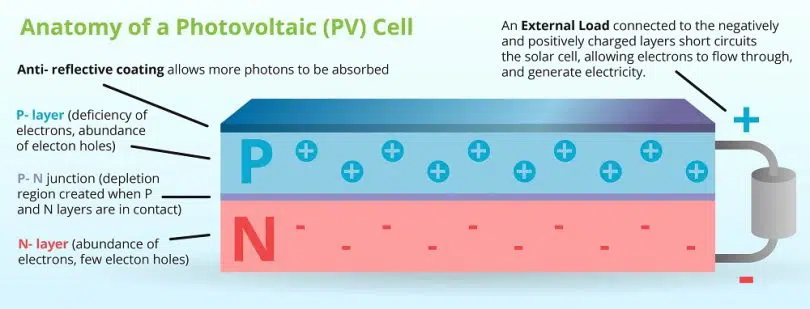
A photon with enough energy should disrupt exactly one electron and this means another hole on the P side. This leads to the creation of a path, and we can use this by adding external elements to the cell to lead this flow of electrons to the P side where they will be united with their holes. This is actually what provides the electrical current and the field causes voltage. This is what we need to have power for our appliances: current and voltage.
Other necessary elements for the solar cell
Up until now we only discuss the most important parts of a solar cell: the silicon based parts and their actions. Still, in order to receive power from a photovoltaic cell and make sure it works at its maximum capacity, we’ll need a few more elements:
- metal plates – these are attached to the side of each cell to create the path for the current;
- antireflective coating – silicon is sometimes so shiny that makes the photons bounce right of it, without having the chance to break an electron free. This means less efficiency for the cell which is why a coating is applied.
These are the main things one should know about solar cells. With the information in here you could produce your own solar cells in case the situation requires it. This is also a fun DIY project that can help you reduce your electricity bills.
How do solar panels work: efficiency and process
Solar Panels or PV modules are nothing else but a series of individual solar cells connected with each other to achieve a certain level of current and voltage. Given the fact that a single cell can’t produce enough energy to power a demanding consumer, the PV modules are the perfect solution.
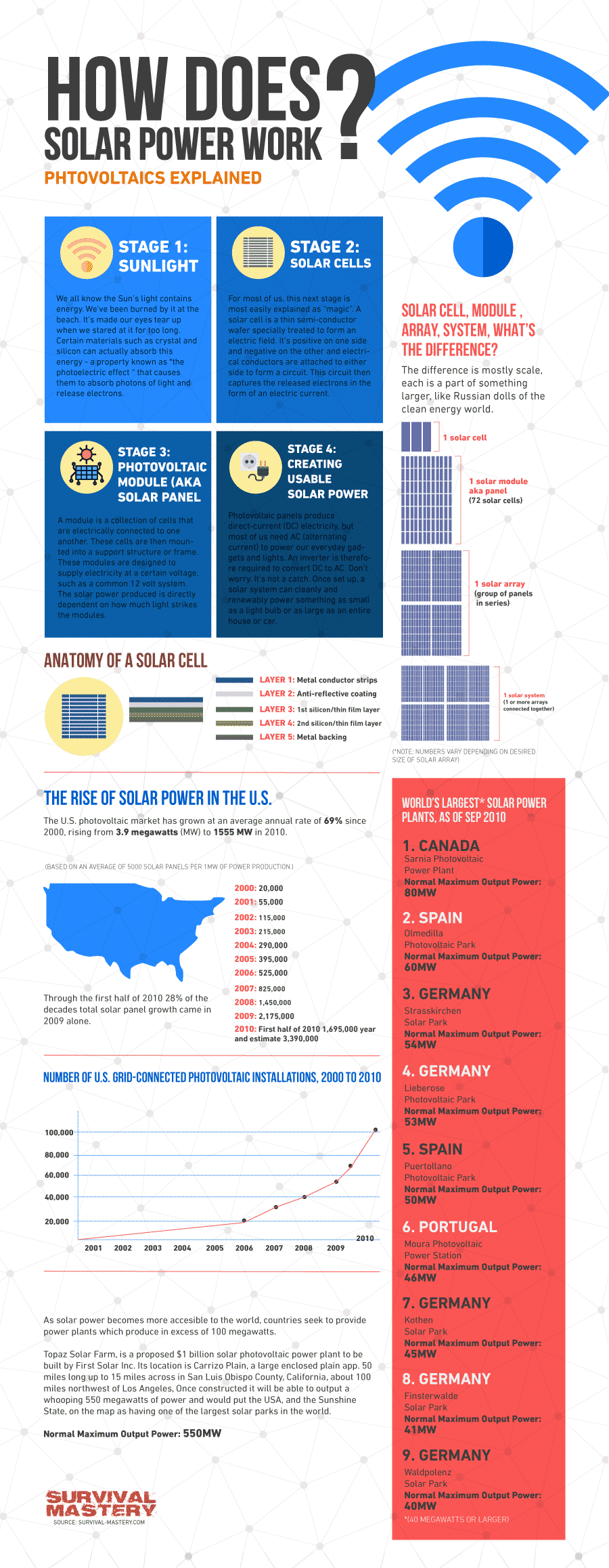
Solar cells need to be protected from the elements in order to produce energy in an effective manner and given the fact that PV modules are installed outdoors, a protective glass cover must be added. So, to summarize, a solar panel is a gathering of solar cells, organized and connected with each other and placed on a sturdy frame, covered with a glass plate. Simple enough, right?
Do check on our article on how to install solar panels to give you more information.
PV modules efficiency
Now that we’ve learned about what makes them tick, let’s see how these PV modules can help us save the money we pay on electricity. Wouldn’t it be fun to be able to consume as much as you need without thinking about how much you’re going to have to pay?
See also: Home Solar Power System: From Modest Kits to Fully Powered Systems
The first thing we’re going to discuss is efficiency, meaning the actual quantity of sunlight energy your panels absorb. You will be surprised to know that the efficiency is not 100%, actually it’s not even close. For example, in 2012, the efficiency in PV modules, destined for household usage was somewhere around 12 to 18%. Still, the numbers have changed since then and thanks to innovative materials, the efficiency managed to go over 50% in 2015 for commercial PV modules. Still, most PV modules that are on the market today don’t feature efficiency greater than 20%.
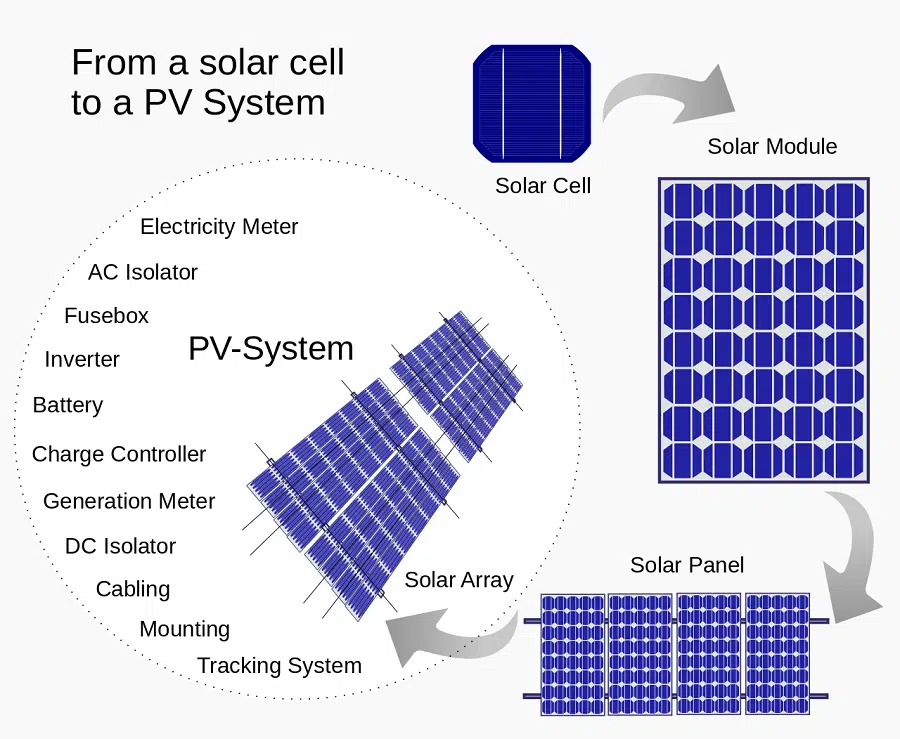
This doesn’t mean that the panels won’t do their job properly; it just means that only 20% of the entire quantity of sun energy that hits your panel will be collected and used for creating electricity. This is why positioning is very important for solar panels. So, why only 20% (or less), why not absorb the entire energy? Well maybe in the future we will be able to use light energy at 100% but for now we are limited by the light itself.
We all know the fact that light is not uniform and that it is made of separated wavelengths (the colors we see in rainbow or when we put a beam of light through a prism). This actually means that different wavelengths will have different levels of energy. Given the fact that it takes a certain level of energy to knock an electron free, some photons will pass through the solar cell without having an impact on it. All this led scientists and manufacturers to understand that only certain wavelengths can actually be efficient in knocking those electrons free.
The necessary amount of energy is expressed in an unit called electron volts (eV) and it depends on the material used to create the cell. For example, the amount of energy required for crystalline silicon is 1.1 eV. This is called in scientific terms, the band gap energy for the specific material.
Now, if a photon is too powerful, then we lose the extra power which is why it is necessary to establish this band gap. Other losses occur with the transport of electrons towards the target destination due to the fact that silicon is a semi-conductor. To minimize these loses manufacturers started using metallic grids to shorten the distance electrons have to travel.
The process of powering your house with solar energy
Now that we’ve discussed several internal aspects of solar panels, it’s time to see how they actually work in a household.
PV Modules’ Orientation
As we’ve already mentioned before, the panels must be orientated towards the sun in order to produce the maximum amount of energy they are capable of. Also, the inclination angle is extremely important which is why the roof of your house may not always be the right answer. PV modules should always be orientated towards south and the angle of inclination must be equal to the latitude of your area (as much as possible).
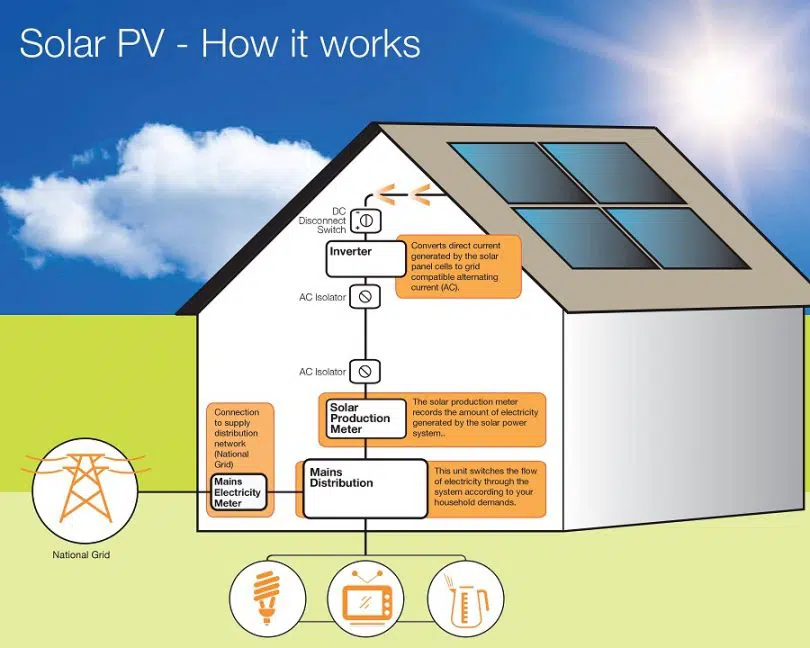
Modules can also be used to maximize energy according to the time of day: more energy in the morning or in the afternoon. Make sure that there is no shadow around the panels as even one shaded cell can change the entire module’s efficiency.
Deciding on the right size
A bigger module will definitely produce more energy than a smaller one given the fact that it incorporated more solar cells. Still, a bigger module will occupy more space on your roof or in your garden and it will be more difficult to maintain. Also, if you’re not using all the energy your module is capable of producing, you will be wasting it and this is not something you want.
[the_ad_placement id=”in-text-3-type-r”]So, how to make sure you have energy all year long with all the weather unpredictability and all? Well the answer is not very difficult. You just have to do some calculations:
- Design for the worst month – look over meteorological data published for last years and check how much sunlight the worst moth had. You should design your system according to these data if you want a constant and efficient flow of energy;
- Calculate your necessities – put the electricity bills together for the last few years and calculate a monthly average. This is the minimum energy you need to obtain with the solar panels during the worst moth of the year (weather wise).
A small trick: to achieve a certain level of voltage, you can wire a few modules in series.
Days without Sun and living completely of the grid
We all know that there are days when the Sun doesn’t shine or it shines too little to produce enough energy for the entire house. This is actually the main problem when it comes to being completely independent on an energetic level: you never know when a rainy day can ruin everything for you and your family. See our piece on how to choose the best portable solar generator for more insight.
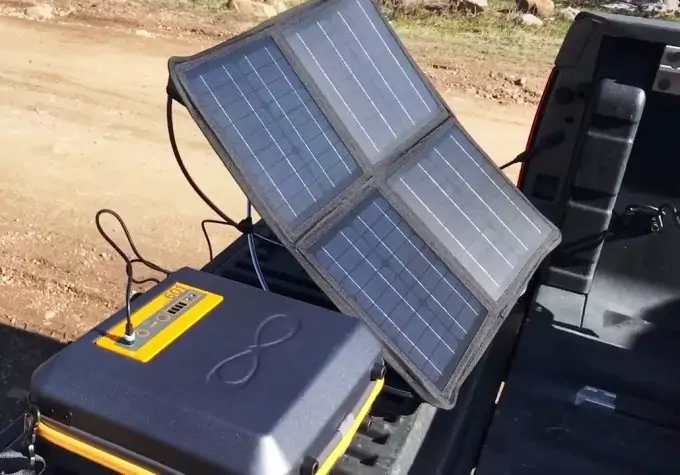
Still, the situation is not completely desperate as there are ways to solve this problem too:
- Batteries to store your energy – you must use a special type called deep cycle batteries. These are capable to discharge a smaller amount of energy and still keep a long life. They need special maintenance and they won’t last you a lifetime – you must replace them every few years. Also, if you want them to keep longer, you’ll need a charge controller so you won’t overcharge them.
- Backup generators – for when your energy income is low. This means that you will actually have to acquire the generator and the necessary fuel and make sure that it can support your entire household for at least a few days.
- Connect to the utility grid – this way when you have too much energy you can sell it to the national system and when yours is too low you can buy. For this you are going to need some special equipment and you’ll need to sign a contract with the national supplier. Local laws can vary from region to region so make sure you get the right information before you start buying the equipments.
Feeding your appliances
Now that you’ve solve the problem with the storage and days without sunlight, you must solve another one. The electric current produced by your PV is direct and your appliances are not made to be powered with it. You will need to buy an inverter and all the equipments required to install it in order to use the solar energy to power your household.
In conclusion
It may seem like a lot of work and it may be a big investment but, in time, you’ll manage to recover it. Only the idea of living completely off the grid and not be dependent of a national system that charges you every month with overpriced energy should be a pretty strong motivation.
For more alternative sources of energy for the home, don’t forget to read our article on this important topic.


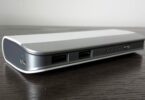

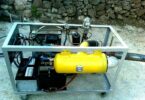

In regards to maintaining solar panels, it should be taken down at least once a month, preferably late at night or early morning. This makes the solar cells more efficient and prevents malfunction and corrosion in the long run.
Generally, solar panels don’t need to be cleaned. If you live somewhere
where there is a lot of smog, dust, or dirt, you may see a dip in your
production over time that can be remedied by cleaning your panels.Your take down routine is effective, but you should consider hiring professionals if the maintenance process proves to be challenging.
The government should support the commercial use of solar energy. For starters, they can offer loans to public transport groups to convert or buy vehicles that use solar panels so we’d lessen being dependent on oil and we will be able to reduce pollution.
That’s a great suggestion, Andrew. You can also learn a lot from our article.